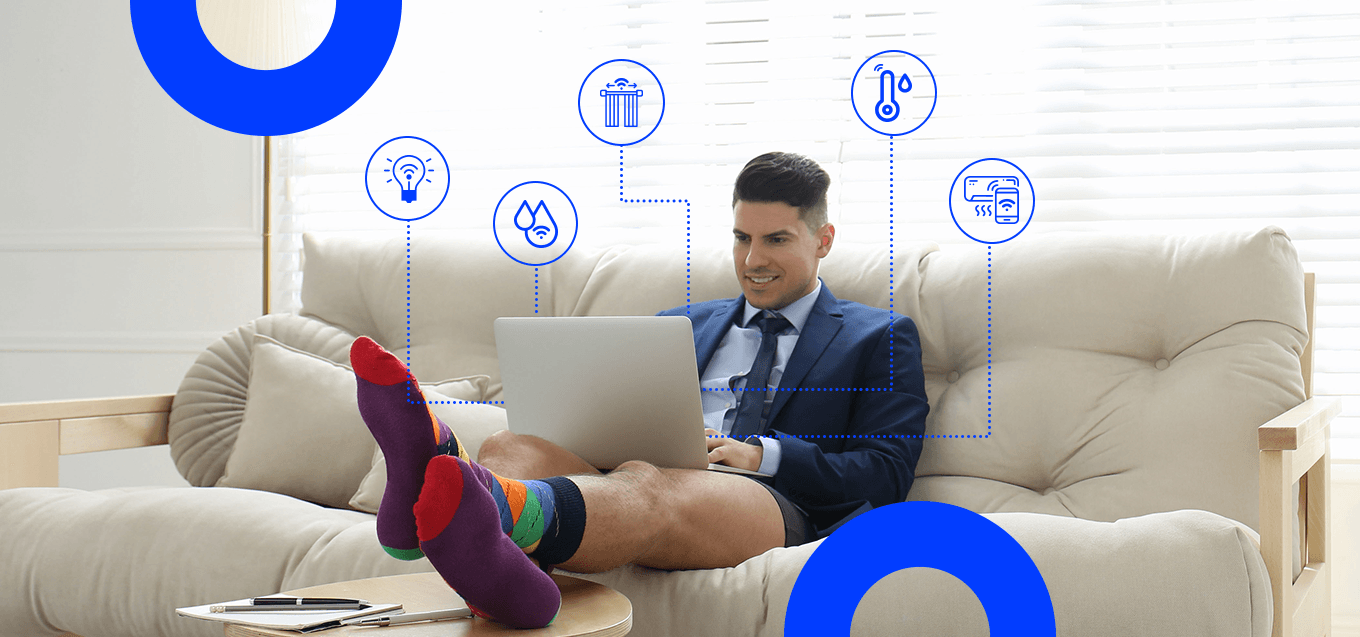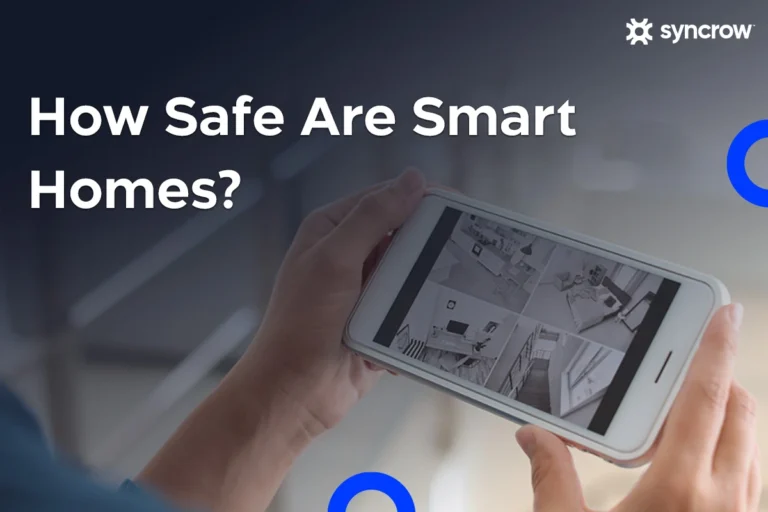Our living environment is experiencing a dramatic transition, aided by smart technologies. Beyond residents’ basic practical needs, the rapid growth of technology ushers in a more efficient mode of human-oriented connection to better address the emotional needs of home occupants. As a result, the definition of “living space” extends much beyond physical architecture and interior décor.
Meeting expanding consumer expectations in modern living has never been more vital for industry players, who are now confronted with new prospects brought about by the rise of smart homes. Smart Home automation converts any ordinary home into a fully automated environment that is dependable, scalable, cost-effective, sustainable, energy efficient, and user-friendly. Syncrow also seeks to build sustainability in future smart homes by integrating your home’s lifeline, energy, with digitalisation to help you accomplish your carbon neutral goals.
The term ‘smart home’ refers to any home that is automated and equipped with Internet of Things (IoT) devices which are linked to mobile applications. The Internet of Things makes objects and appliances “smarter” and more helpful, and the attractiveness of the IoT-powered smart home in this situation is convenience enabled by automation.
Automating homes includes the integration of everyday devices via wireless IoT data networks through a combination of hardware, communication, and electronic interfaces. In terms of a connected living area, there are five categories to consider: energy, entertainment, safety and security, communications, and appliances. The true promise of a smart home is getting all of those devices to work together effortlessly.
A smart home system can be used to automate mundane tasks such as turning on the lights, locking the front door, or reducing the temperature of any room in the house, configuring and monitoring your home security system and cameras, and operating appliances like your refrigerator or air conditioning and heating with little to no manual intervention after setup.
How Does Home Automation Work?
It is becoming increasingly common to build smart homes from the start of the construction process, but technically, any home with an internet connection and an IoT device can be considered a smart home. Syncrow uses Zigbee, a specification that has existed for over a decade and is widely regarded as an alternative to Wi-Fi and Bluetooth for various applications such as low-powered devices that do not require a lot of bandwidth. Advanced protocols such as Zigbee, compared to the internet, are not hackable and do not create traffic on the router.
A home automation system consists of three main components: sensors, controllers, and actuators.
- A sensor can detect changes in daylight, temperature, or motion. You can then customise these settings (and more) to your desired preference with a home automation system.
- Controllers are the computers, tablets, or smartphones that are used to transmit and receive messages regarding the state of automated systems in your house.
- An actuator is a device that controls a home automation system’s mechanism, or function, such as a light switch, a motor, or a motorised valve. Activation is pre-programmed or controlled remotely via a controller.
Setting up your smart home is easier than ever, but selecting the proper smart home system to integrate your devices and have them connected to each other is a major decision.
What Is An Ideal Smart Home?
A smart home integrates traditional home systems into a smart yet sustainable environment that prioritises health, safety and security, energy and water savings, and, most importantly, the home owner’s comfort. Devices in a smart home are interconnected via wireless IoT data networks, allowing the user to automate features such as home security, heating, lighting, and a home theatre. Therefore, instead of operating appliances, thermostats, lighting, and other functions with many devices, homeowners can manage them all with a single device—typically a smartphone or tablet.
There is no limit to the convenience that smart homes can provide for their users. After a hard day’s work, users can come home to a garage that automatically opens for them upon arrival, a house programmed to be the most comforting temperature, the lights turned on so they don’t have to walk into a dark house all while their favourite music lightly drifts throughout the house.
Consumers can also improve their efficiency with home automation. Smart home systems can learn homeowners’ behaviour and cool the house before they arrive home after work rather than leaving the air conditioner running all day. It is the same with appliances. Smart irrigation systems will water the lawn only when it is necessary and with the right amount of water. It can help save both natural resources and money for the consumer by making energy, water, and other resources more efficient.
Benefits of a smart home include:
01. Remote access
Being able to integrate all of your house’s technology through a single interface is a huge step forward for technology and home management. In theory, all you’ll need to do is learn how to use one app on your smartphone or tablet to access a plethora of functions and gadgets around your home. For new users, this significantly reduces the learning curve and makes it easier to achieve the functionality that they really want.
02. Flexibility
Being able to integrate all of your house’s technology through a single interface is a huge step forward for technology and home management. In theory, all you’ll need to do is learn how to use one app on your smartphone or tablet to access a plethora of functions and gadgets around your home. For new users, this significantly reduces the learning curve and makes it easier to achieve the functionality that they really want.
03. Energy efficiency
Being able to integrate all of your house’s technology through a single interface is a huge step forward for technology and home management. In theory, all you’ll need to do is learn how to use one app on your smartphone or tablet to access a plethora of functions and gadgets around your home. For new users, this significantly reduces the learning curve and makes it easier to achieve the functionality that they really want.
04. Convenience
Being able to integrate all of your house’s technology through a single interface is a huge step forward for technology and home management. In theory, all you’ll need to do is learn how to use one app on your smartphone or tablet to access a plethora of functions and gadgets around your home. For new users, this significantly reduces the learning curve and makes it easier to achieve the functionality that they really want.
05. Safety
Being able to integrate all of your house’s technology through a single interface is a huge step forward for technology and home management. In theory, all you’ll need to do is learn how to use one app on your smartphone or tablet to access a plethora of functions and gadgets around your home. For new users, this significantly reduces the learning curve and makes it easier to achieve the functionality that they really want.
What Is The Future Of Smart Homes?
Because of the overwhelming customer interest in smart home technology, the world’s largest tech companies and entrepreneurs have launched a race to outdo one another. That means that bigger, better smart home equipment is continually being developed to meet our digital needs, and the industry is on a meteoric rise.
- Interoperability will be the norm|
There are many disparate smart home systems that operate on different protocols and share different types of data. We are still far from the dream of seamless, connected homes despite the proliferation of devices. Consider entertainment, utilities – such as heating, lighting, irrigation, and security – on a holistic scale.
- Small steps will make a big impact
Sensors and IoT devices will get smaller, less power-consuming, and longer-range in the smart home in order to track and alert when things look out of the ordinary. In the smart home, data will not always need short-range, uninterrupted, high-frequency connectivity – which means data is truly “everywhere.”
Rather than high-bandwidth data dumps, there will be solutions that benefit from a continuous “pulse” of data – small packets moving quickly and having a large impact. It is predicted that connectivity technology that consumes more energy and power will be restricted to specific applications such as video streaming, television and gaming, in addition to enabling remote-first work policies.
- IoT as a catalyst for good
In addition to providing a gateway for other smart home applications, smart home penetration strengthens the opportunity for IoT to spark social and environmental change. Connected consumers tend to be conscious consumers. There are also many homeowners already making steps toward being better stewards of the communities in which they live in, and that stewardship can extend to the home as well. This can be achieved for consumers through connected IoT devices, such as pay-as-you-drive insurance or incentives designed for electric and green vehicles.
When it comes to the current position of the industry in UAE as of 2022, the Smart Home market is expected to generate US$60.07m in revenues. A projected market volume of US$96.57m is expected by 2026, resulting in an annual growth rate of 12.60%. By 2026, there will be 0.4 million active households in the Smart Home market.
As consumers gain control over their homes, footprints, and impacts on the communities in which they live, a ripe market opportunity continues to open up. Smart homes are closer to becoming reality thanks to IoT-powered devices that are low-power, long-range, and cost-effective.




